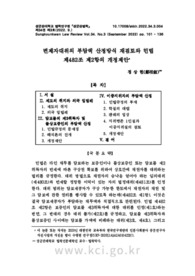

PARTNER
검증된 파트너 제휴사 자료
물상보증인과 담보물 제3취득자 사이의 변제자대위 (A Study of the Subrogation of Guarantor in rem and a Third Party Acquirer of Collateral)
53 페이지
최초등록일 2025.06.23
최종저작일
2024.12

-
미리보기
서지정보
· 발행기관 : 민사법의 이론과 실무학회
· 수록지 정보 : 민사법의 이론과 실무 / 28권 / 1호 / 31 ~ 83페이지
· 저자명 : 성덕근, 정상현
초록
물상보증인으로부터 담보물을 취득한 제3자가 보증인이나 다른 물상보증인에 대하여 채권자를 대위할 수 있는지에 대해서는 여전히 견해가 대립되고 있지만 명시적인 판례는 없다. 민법은 보증인이 주채무를 변제한 경우 제3자에 대해 채권자를 대위할 수 있음을 제482조 제2항 제1호에 규정하고, 그 반대의 경우로서 제3취득자가 변제하거나 담보부동산의 경매로 변제의 결과가 야기되더라도 그는 보증인에게 대위할 수 없음을 제2호에 규정하였다. 하지만 민법 어디에도 물상보증인으로부터 담보물을 취득한 제3자를 채무자로부터 취득한 제3자와 구분하여 특별히 취급해야 한다는 취지는 규정된 바 없다. 만약 이와 달리 해석하려면 그 타당성과 필요성이 명확해야 하는데, 양자를 구별해야 한다는 주장을 위해 제시되는 근거에서는 이를 발견하기 어렵다. 물론 일본민법처럼 개정을 통해 물상보증인형 제3취득자를 물상보증인과 동일하게 본다는 명문의 규정을 두는 것은 정책적인 해결방안으로서 제시될 수는 있다.
변제자대위에서 제3취득자는 이미 타인의 채무를 담보하기 위해 제공된 부동산을 취득한 자인데, 그는 만약에 발생할 수 있는 소유권의 상실이라는 위험을 적어도 그 소유물의 가액 범위에서 감수하겠다는 의사를 가진다. 이러한 타인 채무의 담보의사는 그가 ‘채무자형 제3취득자’인지 ‘물상보증인형 제3취득자’인지와 관계없이 동일하므로, 이들이 취득한 부동산이 누구의 소유였다는 사실이 그들의 법적 지위를 다르게 하는 요소가 되어서는 안된다.
평석대상인 ‘대법원 2024. 7. 31. 선고 2023다266420 판결’에서 대법원은 “수인의 물상보증인 또는 그로부터 담보의 목적이 된 부동산에 관한 소유권 등을 취득한 제3취득자 중 1인이 … 다른 물상보증인 또는 그로부터 담보의 목적이 된 부동산에 관한 소유권을 취득한 제3취득자에 대하여” 구상권의 범위 내에서 변제자대위가 가능하다고 판시하였는데, 이는 물상보증인형 제3취득자의 물상보증인에 대한 대위 가능성과 관련하여 ‘물상보증인형 제3취득자도 보증인 또는 물상보증인에 대하여 채권자를 대위할 수 있는 것’으로 해석될 수 있는 여지가 있는 표현이어서 오해의 소지가 있다. 대법원의 판단은 타당하고 합리적이어야 하며 판시사항은 명확하고 구체적으로 표현되어야 한다. 그러므로 대법원의 판결은 법적 안정성과 사법의 위상을 유지하기 위한 최후의 보루로 존중되어야 하고, 법관이 만든 법(judge made law)으로서 보다 신중한 판시가 필요하다 할 것이다.영어초록
There is ongoing debate as to whether a third party who has acquired collateral from a guarantor in rem may subrogate the creditor against the guarantor or other guarantors in rem. However, no explicit precedent exists on this matter. The Civil Code stipulates in Article 482 (2) 1. that a guarantor who fulfills the principal obligation may subrogate the creditor against third parties. Conversely, under Article 482 (2) 2, when a third party acquirer fulfills the obligation or the obligation is discharged through the auction of the collateralized property, third party acquirers cannot subrogate against the guarantor. Nevertheless, the Civil Code does not contain any provision that distinguishes a third party acquirer of collateral from a guarantor in rem from one who acquires it from a debtor, nor does it prescribe special treatment for such cases. If an alternative interpretation is to be advanced, its validity and necessity must be clearly established. However, the reasoning typically presented to support the need to differentiate between these two types of acquirers fails to sufficiently justify such a distinction. Of course, a policy-based solution, such as amending the law to include an explicit provision treating a "third party acquirer in the context of a guarantor in rem" as equivalent to the guarantor in rem, akin to the approach of Japanese Civil Law, could be proposed.
In the context of subrogation, a third party acquirer is someone who has acquired property already provided as collateral for another’s debt. Such an acquirer implicitly accepts the risk of losing ownership, at least to the extent of the property's value. This intent to secure another’s debt applies regardless of whether the acquirer is classified as a “debtor-type third party acquirer” or a “guarantor in rem-type third party acquirer.” Consequently, the legal status of such acquirers should not differ based on the source of the property they acquired.
In the Supreme Court decision rendered on July 31, 2024 (Case No. 2023Da266420), the Court held that “multiple guarantors in rem or one of the third party acquirers who obtained ownership or similar rights in the real property used as collacteral from such guarantors in rem, may subrogate the creditors to the extent of their right of subrogation against another guarantor in rem or a third party acquirer who obtained ownership of real property used as collateral from such guarantors.” This statement raises concerns of potential misunderstanding, as it could be interpreted to suggest that a “guarantor in rem-type third party acquirer” is also entitled to subrogate the creditor against a guarantor or guarantor in rem. The Supreme Court’s rulings must be both rational and equitable, with their holdings articulated in clear and specific terms. Thus, the Supreme Court, as the ultimate bastion of legal stability and the authority of the judiciary, should be accorded respect. At the same time, its judgments, as a form of judge-made law, require heightened prudence and precision.참고자료
· 없음태그
-
자주묻는질문의 답변을 확인해 주세요

꼭 알아주세요
-
자료의 정보 및 내용의 진실성에 대하여 해피캠퍼스는 보증하지 않으며, 해당 정보 및 게시물 저작권과 기타 법적 책임은 자료 등록자에게 있습니다.
자료 및 게시물 내용의 불법적 이용, 무단 전재∙배포는 금지되어 있습니다.
저작권침해, 명예훼손 등 분쟁 요소 발견 시 고객센터의 저작권침해 신고센터를 이용해 주시기 바랍니다. -
해피캠퍼스는 구매자와 판매자 모두가 만족하는 서비스가 되도록 노력하고 있으며, 아래의 4가지 자료환불 조건을 꼭 확인해주시기 바랍니다.
파일오류 중복자료 저작권 없음 설명과 실제 내용 불일치 파일의 다운로드가 제대로 되지 않거나 파일형식에 맞는 프로그램으로 정상 작동하지 않는 경우 다른 자료와 70% 이상 내용이 일치하는 경우 (중복임을 확인할 수 있는 근거 필요함) 인터넷의 다른 사이트, 연구기관, 학교, 서적 등의 자료를 도용한 경우 자료의 설명과 실제 자료의 내용이 일치하지 않는 경우
“민사법의 이론과 실무”의 다른 논문도 확인해 보세요!
-
디지털 플랫폼의 콘텐츠 추천 알고리즘과 법적 책임 67 페이지
디지털 플랫폼은 여론 형성과 문화 창출의 핵심 주체로 부상했으며, 이들의 콘텐츠 추천 알고리즘이 사용자의 정보 접근과 소비에 미치는 영향력이 확대되면서 알고리즘의 편향성과 차별성이 사회적 문제로 대두되고 있다. 그러나 알고리즘의 불투명성, 책임 소재의 모호성, 국경을 초월하는 서비스의 특성으로 인해 이에 대한 규율은 쉽지 않은 상황이다. 유럽연합을 위시하여.. -
민법 제126조의 표현대리와 정당한 이유의 존재에 대한 판단 - 대법원 2012. 7. 26. 선고 2012다27001 판결 .. 29 페이지
대상판결은 원심에서 인정하였던 원고의 조사・확인 의무에 대한 적시 없이 원고에게 대리권을 믿은 데 정당한 이유가 존재하는 것으로 판시하였다. 상대방이 대리인의 월권행위에 대하여 어떻게 대응하였는지를 파악하는 것은 상대방의 신뢰가치를 평가하는 데 있어 중요한 사실이 될 수 있다는 점에서 대상판결이 원심에서 인정된 상대방의 조사・확인 의무 이행 여부를 정당한 ..
찾으시던 자료가 아닌가요?
지금 보는 자료와 연관되어 있어요!
문서 초안을 생성해주는 EasyAI



